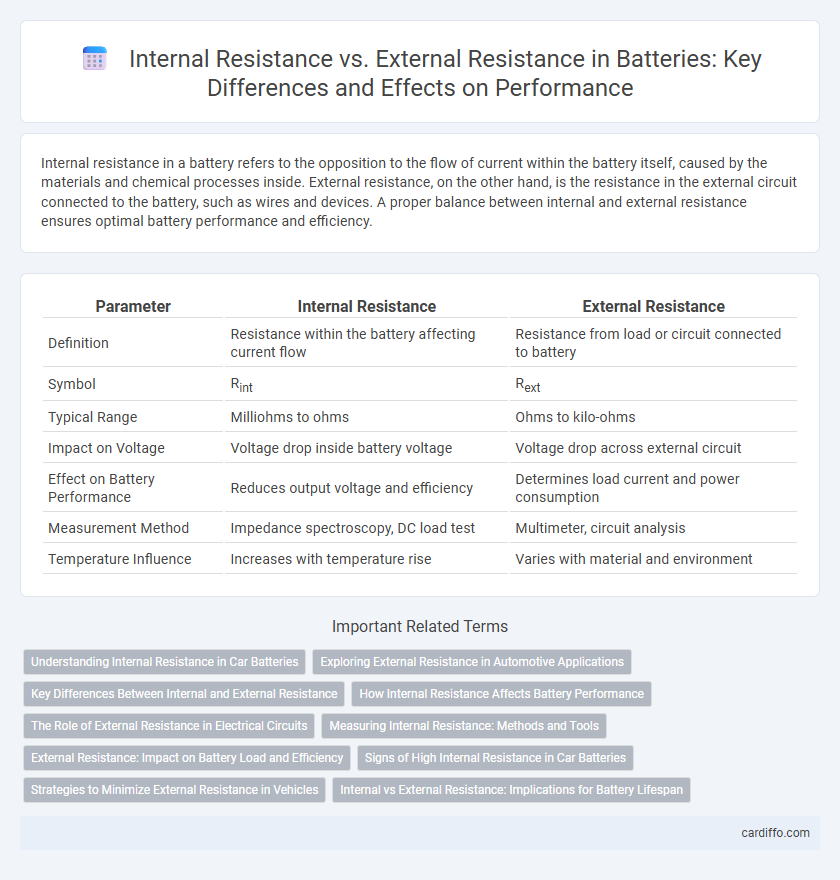Internal resistance in a battery refers to the opposition to the flow of current within the battery itself, caused by the materials and chemical processes inside. External resistance, on the other hand, is the resistance in the external circuit connected to the battery, such as wires and devices. A proper balance between internal and external resistance ensures optimal battery performance and efficiency.
Table of Comparison
| Parameter | Internal Resistance | External Resistance |
|---|---|---|
| Definition | Resistance within the battery affecting current flow | Resistance from load or circuit connected to battery |
| Symbol | Rint | Rext |
| Typical Range | Milliohms to ohms | Ohms to kilo-ohms |
| Impact on Voltage | Voltage drop inside battery voltage | Voltage drop across external circuit |
| Effect on Battery Performance | Reduces output voltage and efficiency | Determines load current and power consumption |
| Measurement Method | Impedance spectroscopy, DC load test | Multimeter, circuit analysis |
| Temperature Influence | Increases with temperature rise | Varies with material and environment |
Understanding Internal Resistance in Car Batteries
Internal resistance in car batteries significantly impacts their performance and efficiency by causing voltage drops during high current demands, such as engine starting. Measuring internal resistance helps diagnose battery health, as increased resistance often indicates aging, sulfation, or corrosion within the battery cells. Maintaining low internal resistance ensures optimal power delivery and prolongs battery lifespan, especially under varying external load conditions.
Exploring External Resistance in Automotive Applications
External resistance in automotive battery applications significantly impacts current flow and overall system efficiency, where higher external resistance reduces current draw, enhancing battery longevity. Optimizing external resistance in circuit design helps balance power delivery to automotive components while minimizing energy loss as heat. Understanding the dynamic interplay between external resistance and battery performance ensures reliable operation of electric vehicles and hybrid powertrains under varying load conditions.
Key Differences Between Internal and External Resistance
Internal resistance in a battery refers to the opposition within the cell that hinders the flow of current, primarily caused by the electrolyte and electrode materials. External resistance is the load resistance connected to the battery terminals, determining the current drawn from the battery. The key difference lies in their impact: internal resistance reduces the battery's effective voltage and causes energy dissipation as heat, while external resistance controls the operational current and power delivered to the load.
How Internal Resistance Affects Battery Performance
Internal resistance in a battery causes energy loss in the form of heat, reducing the overall efficiency and output voltage during discharge. Higher internal resistance leads to greater voltage drops under load, limiting the current supply and shortening runtime in devices. Managing internal resistance is crucial for maintaining optimal battery performance and prolonging lifespan in applications like electric vehicles and portable electronics.
The Role of External Resistance in Electrical Circuits
External resistance plays a critical role in determining the current flow and power dissipation in electrical circuits, directly impacting battery efficiency and performance. By controlling the load connected to the battery, external resistance influences the voltage drop and heat generation within the circuit. Optimizing external resistance ensures maximum energy transfer from the battery while minimizing energy loss due to internal resistance effects.
Measuring Internal Resistance: Methods and Tools
Measuring internal resistance in batteries primarily involves using electrochemical impedance spectroscopy (EIS) and the DC load test method, which provide precise resistance values by analyzing voltage response under controlled current. Specialized instruments like impedance analyzers and battery testers enable accurate assessment of internal resistance, crucial for evaluating battery health and performance. Understanding the difference between internal resistance and external resistance helps optimize battery efficiency and lifespan in practical applications.
External Resistance: Impact on Battery Load and Efficiency
External resistance directly influences the battery load and efficiency by determining the current flow through the circuit, which affects energy delivery and heat generation within the battery. High external resistance results in lower current draw, reducing voltage drop and enhancing overall battery efficiency during discharge. Conversely, low external resistance increases current flow, causing higher internal losses, accelerated battery depletion, and diminished operational life.
Signs of High Internal Resistance in Car Batteries
High internal resistance in car batteries is often indicated by a slow engine crank, dim headlights at startup, and a noticeable drop in voltage under load. These signs suggest the battery's inability to deliver sufficient current, causing performance issues despite a full charge. Diagnosing increased internal resistance early can prevent unexpected battery failure and ensure reliable vehicle operation.
Strategies to Minimize External Resistance in Vehicles
Minimizing external resistance in vehicles involves optimizing wiring quality by using low-resistance copper cables and ensuring secure, corrosion-free connections to reduce voltage drops. Implementing proper routing to avoid excessive cable length and utilizing high-efficiency connectors further decrease resistance in the electrical system. Regular maintenance and inspecting components like fuses and terminals help sustain minimal external resistance, enhancing overall battery performance and vehicle efficiency.
Internal vs External Resistance: Implications for Battery Lifespan
Internal resistance in batteries directly affects energy efficiency and heat generation, leading to faster degradation and reduced lifespan. External resistance determines the current flow during operation, influencing battery performance but not causing internal wear. Minimizing internal resistance through quality materials and design extends battery life by reducing energy loss and thermal stress.
Internal Resistance vs External Resistance Infographic

 cardiffo.com
cardiffo.com